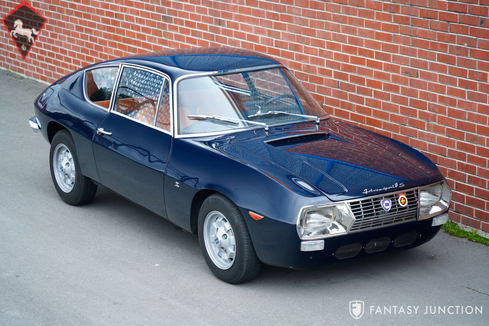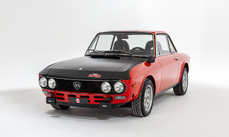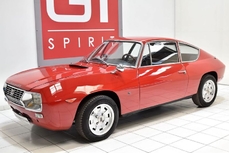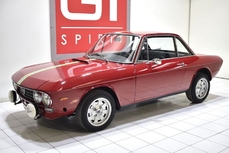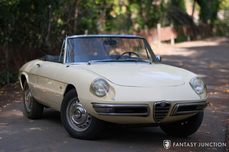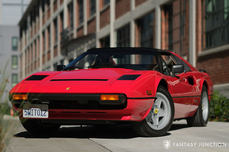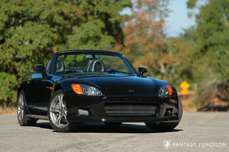Lancia Fulvia 1300cc V4 1972
Allgemeine Beschreibung :
1972 Lancia Fulvia 1,3S Zagato
s/n 818.650.001329, engine no. 818*303*090167*
Dark Blue with Arancia Interior
In today’s market, the phrase “Italian sports car with Zagato coachwork, disc brakes, and twin cam engine” is typically accompanied by deep six-figure price tags. Combine a legacy of innovative technical features and exquisite design and the price climbs further still. Remarkably, the Fulvia Zagato fulfills all the requirements for enjoyable vintage sports car enthusiasts, without requiring a second mortgage.
Highly regarded for their exceptional craftsmanship, innovative engineering, and cost-no-object attention to detail Lancia built some of the most elegant, refined, performance cars in their century long history. Given this philosophy, Lancia frequently found themselves making superb cars but not always following with profit. Among the last of the pre-FIAT cars, the unibody front-drive Fulvia was powered by a dual overhead cam narrow angle common-cylinder head V4 engine. Dunlop disc brakes on all four corners, light alloy component construction, and a host of additionally interesting technical features contributed to its success. Road and Track magazine described the car in 1967 as "a precision motorcar, an engineering tour de force." The Fulvia was surprisingly quick for its displacement and proved to be an effective competition car in both rally and circuit racing. The Fulvia was available in a variety of body styles including the rare and special Zagato coupe bodywork, which provided a unique profile and a surprising amount of space for larger drivers and fortunate passengers
This particular car is an early Series 2 Fulvia Sport 1.3S Zagato. Coachwork was designed and built by Zagato and fitted to the Lancia unibody platform. The Series 1 bodies featured side hinging hoods and rear drop-down spare tire compartments. During the transition from Series 1 to Series 2 cars, the first 600 of the 2600 Series 2 cars were built utilizing Series 1 bodies. This example is one of the transitional 600 Series 2 cars. During this period, the 1.3S was considered the top of the line. Imported to the US from Italy in 2004, this car resided in California from 2011-2023, including ownership with a well-known Northern California Lancia enthusiast who enjoyably used it as part of his sports car collection of Ferraris and other Lancias. The previous owner serviced the car regularly including installing new front ball joints and tie rod ends, rebuilding the generator, and generally servicing the car while making regular trips to events like the 2016 Monterey Historics, local Sacramento area European car tours, and casual car gatherings.
In 2023, the car was sold to the current owner who engaged Maranello MotorWorks, Northglenn, CO to service the car. In April 2023 a comprehensive tune-up was performed including new plugs and correct plug wires, fluids, and two radiator hoses. The rear electric window motor was replaced, new switch relays and wiring installed for more reliable operation, engine electrical wiring tested, select wiring replaced as needed, and both door panels removed to access and improve exterior door lock mechanisms. A new electric fuel pump and vibration isolators were installed along with new fuel hoses and clamps, a new heater cable installed, and a new set of seat belts were installed using structurally suitable mounting points. Further work performed by an independent specialist included replacing the front rubber leaf spring supports using parts purchased from Lancia specialists.
Today, the car presents as an attractive driver, with glossy paint and good panel fit. Close inspection reveals some bubbling at the bottom of the right front fender and the paint displays some chips, scratches, and various other imperfections, but the overall presentation is very attractive. The chrome and various trim are all in good to very good condition, particularly the hard-to-find grille and chrome plated headlight bezels. The lenses, glass, and delicate Fulvia Sport hood script announce the Italian heritage and design excellence, while Zagato badges flank both front fenders. The desirable 5.5” Cromodora wheels are in excellent shape and add a period correct performance stance to the car, giving it just the right amount of rake.
The color-contrasting interior is excellent overall. The clean black vinyl and wood dashboard are handsomely finished. The low-profile bucket seats are in excellent condition with good side bolsters and lower seat support. A small 1/8” hole is noted on the driver’s seat bottom bolster. The door panels, headliner, and wood dash trim are in very good condition. A properly housed clock and rare radio delete plate with Fulvia script finish the dashboard. The gauges and controls feature nice color and contrast, and excellent trim. The correct ribbed and fitted rubber floor mats are similarly nice as is the leather wrapped Lancia steering wheel. Lifting the rear hatch, the rear storage area is finished and trimmed with appropriate materials. Further, the rear hatch can be electronically raised and lowered from a dash switch, allowing cabin ventilation, a quintessentially Lancia feature that is both functional and clever.
The engine compartment is honest and tidy, with generally correct finishes, original components, and properly sorted hardware. The engine is a correct type 303 1.3 series engine, although it is a later serial number than is generally associated with early S2 cars. The engine compartment appears largely original with correct presentation and good detailing. The engine is fitted with a correct set of Solex carburetors with an original air cleaner housing.
The car runs and drives well, starting easily and revving freely. The dogleg 5-speed gearbox has good synchromesh and moves smoothly through all gears. The chassis has a coherent and comfortable feel, perfectly suited for mountain roads and spirited driving. The Fulvia is known for light and communicative steering, delivering precise and responsive results – certainly one of the top characteristics of this model.
This is an excellent opportunity to acquire a rare, technically interesting, and entertaining classic Lancia Fulvia Sport with unique Zagato coachwork. Rarely found in the United States, the Fulvia Sport benefits from robust North American parts sources and excellent club support. This twin-cam, coachbuilt, Italian sports car is ready for the next chapter in enthusiast enjoyment – one that is sure to delight onlookers with the rarity, performance, and unique design befitting the premier Lancia legacy. Included with the sale is a correct Fulvia tool kit.
1972 Lancia Fulvia 1300cc V4 is listed zu verkaufen on ClassicDigest in California by Fantasy Junction for $39500.
Fakten der Auto
Karosserietyp : Auto Marke : Lancia Modell : Fulvia Ausführung : 1300cc V4 Hubraum : 1.3 Modelljahr : 1972 Lage : Emeryville Fahrzeug Anmeldung : Normal
39500 $
Angaben Zum Verkäufer
Fantasy Junction
Fantasy Junction
+1 510 653 7555
Fantasy Junction
+1 510 653 7555
People who viewed this Lancia Fulvia also viewed similar Lancia listed at ClassicDigest
Other cars listed for sale by this dealer
über Lancia
Ah, Lancia, die italienische Marke, die auf dem schmalen Grat automobiler Brillanz getanzt hat! Lass mich dich auf eine Reise durch die fesselnde Geschichte von Lancia mitnehmen, einer Marke, die Leidenschaft, Innovation und Rallye-Erfolg verkörpert.Akt 1: Die Frühen Jahre (1906-1920er)
Lancia wurde 1906 von Vincenzo Lancia gegründet, einem Ingenieursgenie mit einer Vorliebe für das Außergewöhnliche. Die Marke erlangte schnell einen Ruf für ihre präzise Ingenieurskunst und innovative Herangehensweise. Der Lancia Alpha, 1907 eingeführt, war das erste Auto mit einem schmalen V4-Motor und setzte den Ton für Lancias Einsatz für technische Exzellenz.
Akt 2: Innovation im Zentrum (1930er-1950er)
Die 1930er Jahre sahen Lancia die Grenzen der Innovation mit Modellen wie dem Lambda ausloten, dem ersten Auto mit selbsttragender Monocoque-Chassis. Der in den 1930er Jahren eingeführte Aprilia präsentierte wegweisende Aerodynamik und einen V4-Motor und festigte Lancias Ruf als Pionier.
Akt 3: Eleganz der Nachkriegszeit (1950er-1960er)
Nach dem Zweiten Weltkrieg begeisterte Lancia weiterhin mit Modellen wie dem Aurelia, dem ersten Serienauto mit einem V6-Motor. Es verband Leistung mit Komfort und Eleganz. Der Flaminia folgte und verkörperte Luxus und fortschrittliche Technik.
Akt 4: Rallye-Dominanz (1970er-1980er)
Lancia hat sich mit einer beispiellosen Rallye-Geschichte einen Platz in der Motorsportgeschichte gesichert. Der Lancia Stratos, ein keilförmiges Wunder, dominierte die Rallyeszene in den 1970er Jahren und holte von 1974 bis 1976 drei aufeinanderfolgende Rallye-Weltmeisterschaften. Der Delta Integrale, in den 1980er Jahren eingeführt, setzte diese Rallye-Herrschaft mit mehreren Meisterschaften fort.
Akt 5: Herausforderungen und Widerstandsfähigkeit (1990er-2000er)
Das späte 20. Jahrhundert brachte finanzielle Herausforderungen für Lancia mit sich, was zu Zusammenarbeiten mit anderen Automobilherstellern führte. Trotz der Schwierigkeiten führte Lancia Modelle wie den Thesis und den Ypsilon ein, die den Einsatz für Stil und Substanz zeigten.
Akt 6: Neuerfindung im 21. Jahrhundert (2010er-Heute)
In den 2010er Jahren konzentrierte sich Lancia auf die Ypsilon als Hauptmodell, um die Markenstrategie neu auszurichten. Obwohl die Produktionszahlen zurückgingen, behielt die Marke ihren Ruf für unverwechselbares Design und Komfort bei.
Epilog: Ein Erbe von Leidenschaft und Innovation
Lancias Geschichte ist eine von Leidenschaft, Innovation und Motorsporterfolg. Die Marke, mit ihren bahnbrechenden Designs, technologischen Fortschritten und Rallyetriumphen, hat einen unauslöschlichen Eindruck in der Automobilwelt hinterlassen. Lancia mag in den letzten Jahren Herausforderungen gegenüberstehen, aber ihr Erbe lebt weiter, gefeiert von Enthusiasten, die die Magie in jedem Lancia-Werk erkennen
